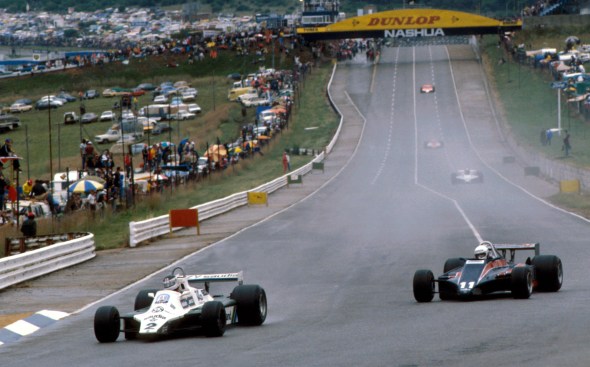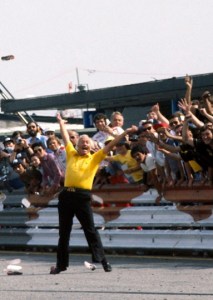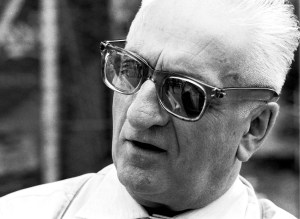This was an article written by Samantha for the 2000 special edition commemorative magazine – F1-50 Fifty Golden Years of Formula One – celebrating 50 years of the FIA Formula One World Championship.

Over the past 20 years Formula One Grand Prix racing has become the most popular form of motorsport in the world. Fuelled by the development of global television coverage, it has grown enormously. It was a rate of growth that would not have been possible without the changes stimulated by the FISA-FOCA war in the late 70’s, early 80’s, leading to the signing of the Concorde Agreement, which would become the universally recognised document by which the sport was governed.
The FISA-FOCA war defined and shaped the sport of Grand Prix racing, and thus allowed it to develop into the business it has become. That much is widely known. But the story behind Formula One’s ‘war of independence’, and the people who identified and optimised the potential of television rights as an asset in order to make Formula One the multi-million dollar sport that it is today, is less well-known. It is highly unlikely that Formula One would have developed at the rate that it has without its comprehensive review of the way in which the sport operated and assigned responsibility – a review forced by this war in January and February 1981.
In the 60’s and early 70’s there was little sport-generated income for the participating teams and naturally, the most prominent teams at the time were championship-winners Ferrari, Lotus, BRM and Brabham. The formation of FOCA (The Formula One Constructors Association) was driven to a large degree by the success of BRM and Lotus between 1962 and 1968, success which was not reflected in the earning capacity and the standing of the teams with the CSI (Commissions Sportive International, the forerunner of the FIA). At this time the rewards from the promotion and running of races mainly went to the CSI or the promoters/circuits, while the performers – the teams – were more the poor relations. Despite a relatively lean period of competitiveness for Ferrari, the Italian team still held great sway with the governing body in the formation of rules and the direction of the sport, partly because it had been racing since the World Championship’s inauguration in 1950. There was relatively little money from commercial sponsorship and the teams were dependent largely on ‘starting money’ which was paid by the circuit promoters to teams to attend races. This was in turn dependent on a team’s drawing power. Thus it was not distributed evenly. Traditionally Ferrari had always managed to procure the largest share, with the British teams being left to negotiate for the remainder even though they had been dominant since the late 50’s. The teams’ primary funding at this time came from fuel and tyre companies, as Formula One was viewed more as a contributor to motor industry technology than as an advertising medium. The publicity generated by the sport at this time was relatively small and specialised, which necessarily meant that sponsorship opportunities were limited. The teams’ discontent stemmed from the fact that they had no control over the distribution of ‘starting money’ or the rules, while any technical changes – which were made about every 5 years – were determined by the CSI with influential lobbying by Ferrari, and other manufacturers of long standing. As they still do to this day, such technical changes inevitably meant high investment for the teams, and this created much greater problems for the independent, privately owned teams such as Lotus, BRM and Brabham, than it did for Ferrari, which generated an income from its road car manufacture. The British teams became increasingly frustrated and dissatisfied with the level of input they had in these matters, and the potential for catastrophic consequences as a result of arbitrary changes for their small teams. Back in the early 60’s this had particularly manifested itself in the British teams’ refusal to believe that the CSI would go ahead with plans to introduce a 1.5-litre Formula One for 1961. When they did indeed go ahead, Ferrari had a significant advantage for the first season, until the British teams took their heads out of the sand and caught up.
This situation was also reflected in other aspects of the Formula One business. The general dissatisfaction brought about the establishment of the Formula One Constructors Association in 1968, to represent all the teams and prevent their exploitation by either the CSI or race promoters. As a united body with a common stance, FOCA negotiated with promoters for the total amount of ‘starting money’ available, and then proceeded to distribute it amongst its members using its own secret formula related to team standing over the last season and team performance at the time. It also negotiated with the CSI on technical matters, defined much of the criteria for the safety of circuits, set the standards for pit and paddock conditions, ensured adequate admittance passes and other facilities such as media resources and consistency of programme timetables. Having a common bond and objective, FOCA were able to use their unity to raise these matters with what became the FISA in the late 70’s, and push for improvements.

The FISA-FOCA war itself erupted over a technical disagreement concerning the implications to safety of ground-effect – the harnessing of under car aerodynamic forces to generate superior roadholding – which was being used at the time by the British teams to challenge the more powerful turbo and and normally aspirated flat-12 engines that Ferrari, Renault and Alfa Romeo were using. The engine had always been the heart of a Ferrari, and was a particular area of expertise for the Italian team. Because of limited resource and options on the engine front, chassis development was the area which the British teams had habitually focused on. The aerodynamic and dynamic chassis developments pioneered by the them during the 70’s, especially with the utilisation of ground-effect, came suddenly. Speeds increased rapidly, leaving Ferrari in particular floundering with its wide flat-12 engine which largely prohibited effective ground-effect design around the all-important underside and rear end of the car.
A lobby soon emerged within the FISA that this ground-effect technology was creating cornering speeds that were too high, thereby creating a safety problem. In addition to the effect on Ferrari’s competitiveness, this ‘safety’ problem meant potentially that significant investment would be required of the circuit owners. This was expenditure that, naturally, they would have preferred to avoid. At the time the President of the FIA and the FISA (which then was the sporting arm of the FIA), was a bombastic Frenchman named Jean Marie Balestre. He decided that ground-effect would be banned immediately, which obviously caused outcry from the British teams. This discontent among the British teams, who had made such effective use of ground-effect than either Ferrari or Renault, generated a split. The so-called ‘grandee’ manufacturers (those who made both the chassis and the engine) looked down their noses at what they dismissed as the British ‘garagistes’, who merely put somebody else’s engine in their home-built ‘kit-cars’. Naturally, such a disparaging attitude bred further ill-feeling, particularly because back then the ‘garagistes’ had a far better idea of what made a Formula One car go fast than any of the ‘grandees’.
By the end of the 1980 season, with both sides thoroughly entrenched in their views, FOCA proposed to run their own World Championship. This new series would be sanctioned by a new governing body called the World Federation of Motor Sport (WFMS), which would be headed, with full approval of the garagiste teams by Brabham owner, Bernie Ecclestone. Legal representation for the WFMS would be provided by the former owner co-founder of March Cars, Max Mosley, a trained barrister.
The WFMS produced regulations and a draft calendar to show the FIA that it meant business, while the FISA published their own provisional calendar for the teams loyal to its championship; Ferrari, Renault, Alfa Romeo, Osella and Toleman (the only British team to make its own turbo engine, under the auspices of Brian Hart). FOCA’s first attempt at running its own game was a pre-season event in Kaylami, South Africa in February, 1981. It turned out to be a great disappointment for FOCA, as a very small crowd attended, and it received relatively poor press coverage. It was a strong warning to FOCA that a World Championship without all the historical protagonists would not generate the necessary appeal to the spectating public. This message was not lost on the FISA and their loyal teams either. The writing was clearly on the wall for all parties: the split and arguing was damaging the sport as a whole. The public, and more importantly the sponsors, who were demanding stability around which to build marketing programmes, would not tolerate such instability for very long.

Despite a commitment to support Balestre to the end, even Renault could not ignore the potential disaster ahead if the dispute and the split continued, and its stated intent in early 1981 to be at the Grand Prix scheduled for Long Beach in April, with or without Balestre, soon focused the President’s mind. Balestre realised he had to move quickly to negotiate peace with the renegade teams, or the FISA’s Formula One empire could be damaged irreparably.

This series of events brought the conflicting parties, FISA and FOCA, together to discuss a way ahead. The process highlighted the need to not only reach a solution, but also to define areas of authority and responsibilities once and for all. In a series of meetings, all the issues related to the future operation and development of the Formula One World Championship were tabled, including how the rules would be formulated, what input the teams could have on rule making, and how they would be modified, implemented and enforced. When it came to television, the FISA recognised that this needed to be co-ordinated through one office and as the teams were the main performers, the rights to manage and negotiate television coverage of Formula One would best be dealt with by the Formula One Constructors Association. In effect, this meant FOCA’s president Bernie Ecclestone, who had already demonstrated expertise and success in dealing with this area. While the FIA recognised that it did not have the expertise to develop and exploit the Formula One TV opportunity, Ecclestone more than anybody else recognised the relationship of TV and sport and that the future development of Formula One as a business would be inextricably linked to the exposure it generated on television. In addition FOCA were given responsibility for the administration of Grand Prix events with authority over general discipline, credentials and pass distribution. The FISA would retain the rights to the Formula One World Championship and would provide the sanctioning authority for events comprising the Formula One World Championship. The FISA then created an infrastructure of Commissions to deal with the various aspects of Formula One’s legislative operation, which provided the environment in which stability could be established, and in which the sport could be developed and administered.
Without the technical dispute generated by ground effect in the late 70’s which sparked the FISA-FOCA war, Formula One would have continued it’s meandering progress, although it is likely some other issue whether technical or sporting would sooner or later have brought things to a head.
Similarly there is no doubt that the War came at a very appropriate point in time, as did the resulting Concorde Agreement and its distribution of responsibilities.

The economic and electronic media explosion of the 80’s, the search for excellence in technology and operation within the Formula One teams, and the infrastructure afforded by the Concorde Agreement, provided the ideal environment for the development of Grand Prix racing. This chemistry, when combined with the vision and expertise of Bernie Ecclestone accelerated the sport’s profile and development at an amazing rate . There are few, if any, sports today to equal Formula One Grand Prix racing in terms of exposure, and much of the credit for this must go to Ecclestone. But the contribution of key individuals such as Jean Marie Balestre, Enzo Ferrari, Colin Chapman and Ken Tyrrell should not be forgotten.
These men were the architects of the War and of the Peace. They had the vision to recognise the potential of the sport and to define an effective structure for its future. It was an acrimonious time for Formula One and it was some time before all the ruffled feathers had been smoothed down again, but the legacy of their efforts is the success and popularity of Grand Prix racing today.
Samantha’s thanks go to Sir Jackie Stewart, Keke Rosberg, Sir Frank Williams and David Tremayne who unselfishly shared their knowledge and experience of this period, during her research and in the preparation of this article.

Special thanks to the late Jabby Crombac whose unique, first hand knowledge of Balestre’s perspective was invaluable.
All photos © Sutton Images
